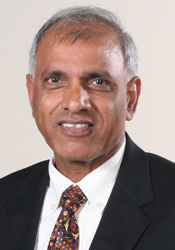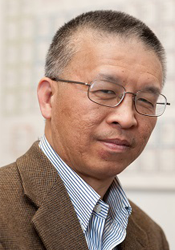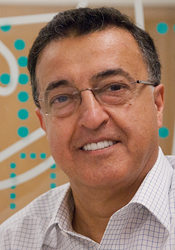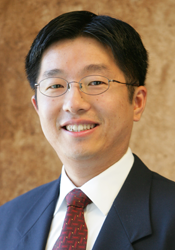2016 Prager Medalist – J. N. Reddy
2016 Eringen Medalist – Gang Chen
2016 Taylor Medalist – Morteza (Mory) Gharib
2016 Young Investigator Medalist – Teng Li
 2016 Prager Medalist
2016 Prager Medalist
J. N. Reddy
PLENARY TALK: On Non-Local and Strain Gradient Theories In Structural Mechanics: An Overview
ABSTRACT: Structural continuum theories require a proper treatment of the kinematic, kinetic, and constitutive issues accounting for possible sources of non-local and non-classical continuum mechanics concepts and solving associated boundary value problems. In the case of solid and structural mechanics, there is a wide range of theories (see, e.g., Mindlin and Eringen), from higher gradient to truly nonlocal; however, there is a need for physical explanations and experimental observations that systematically corroborate these theories and provide physical interpretations of the parameters introduced in these theories. In this lecture, an overview of the author’s recent research (with his colleagues) on nonlocal elasticity and couple stress theories in formulating the governing equations of functionally graded material beams and plates will be presented. In addition to Eringen’s nonlocal elasticity (1972), two different nonlinear gradient elasticity theories that account for (a) geometric nonlinearity and (b) microstructure-dependent size effects are revisited to establish the connection between them. The first theory is based on modified couple stress theory of Mindlin and the second one is based on Srinivas-Reddy gradient elasticity theory. These two theories are used to derive the governing equations of beams and plates. In addition, some recent developments as an alternative to peridynamics idea of Silling will also discussed briefly.
BIO: Dr. Reddy is a Regents Professor, Distinguished Professor,and the inaugural holder of the Oscar S. Wyatt Endowed Chair in Mechanical Engineering at Texas A&M University, College Station, Texas. Dr. Reddy is the author of over 560 journal papers and 20 text books on theoretical formulations and finite-element analysis of problems in solid and structural mechanics (plates and shells), composite materials, computational fluid dynamics, numerical heat transfer, and applied mathematics.
Dr. Reddy is also internationally-recognized for his research on mechanics of composite materials and for computational methods. The shear deformation plate and shell theories that he developed bear his name (Reddy third-order shear deformation theory and Reddy layerwise theory) in the literature. The finite element formulations and models he developed have been implemented into commercial software like ABAQUS, NISA, and HyperXtrude.
In recent years, Professor Reddy and his colleagues pioneered the development of 7- and 12-parameter shell theories and nonlocal beam and plate theories using the ideas of Eringen, Mindlin, Koiter, and others. He and his colleagues developed a thermodynamically based strain gradient elasticity theory that contains Mindlin’s model as a special case. His group is also working on (internal) polar continuum theories in the derivations of the conservation and balance laws.
Dr. Reddy received numerous awards, including: the Charles Russ Richards Memorial Award and the Worcester Reed Warner Medal from the American Society of Mechanical Engineers, Raymond Mindlin and Nathan M. Newmark Medals from the American Society of Civil Engineers; Award for Excellence in the Field of Composites and Distinguished Research Award from the American Society for Composites, the Computational Solid Mechanics award from the USACM, and the IACM Award from the IACM. Dr. Reddy is elected to National Academy of Engineering and as a Foreign Fellow of the Indian Academy of Engineering. He will be honored with the ASME Medal in November at the Honors Assembly of ASME.
 2016 Eringen Medalist
2016 Eringen Medalist
Gang Chen
PLENARY TALK: Phonon Heat Conduction Beyond Fourier Diffusion: Ballistic, Coherent, Localized, Hydrodynamic, and Divergent Modes
ABSTRACT: Fourier law of heat conduction is one of the bases for analyzing thermal problems. It has been recognized that Fourier law has limitations. In this talk, I will discuss different modes of heat conduction in nanostructures. Ballistic transport happens when phonon mean free path is longer than the characteristic size of the structure. I will discuss how we compute phonon mean free path distributions based on first-principles and measure the distributions with optical pump-probe techniques by exploring ballistic phonon transport processes. In superlattice structures, ballistic phonon transport across the whole thickness of the superlattices implies phase coherence. We observed this coherent transport in GaAs/AlAs superlattices. Accessing the coherent heat conduction regime opens a new venue for phonon engineering. I will further show that phonon heat conduction localization happens in GaAs/AlAs superlattice by placing ErAs nanodots at interfaces. In an opposite direction, we will discuss phonon hydrodynamic transport mode in graphene via first-principle simulations. In this mode, phonons drift with an average velocity under a temperature gradient, similar to fluid flow in a pipe. Furthermore, it is also possible to have infinite heat thermal conductivity, as suggested by the Fermi-Pasta-Ulam discovery of nonergodic behavior in one-dimensional nonlinear atomic chain in 1950s. This divergence could exist in real materials such as polymer chains. New understandings in these nondiffusive heat conduction phenomena are stimulating developments of new materials. One example is thermoelectric energy conversion for which phonon thermal conductivity is to be minimized while maintaining electron transport properties. Another example is high thermal conductivity in ultra-drawn polyethylene nanofibers and sheets. Progress in these areas will be highlighted.
BIO: Gang Chen is currently the Head of the Department of Mechanical Engineering and Carl Richard Soderberg Professor of Power Engineering at Massachusetts Institute of Technology (MIT), and is the director of the “Solid-State Solar-Thermal Energy Conversion Center (S3TEC Center)” – an Energy Frontier Research Center funded by the US Department of Energy. He obtained his PhD degree from the Mechanical Engineering Department, UC Berkeley. He was a faculty member at Duke University and UCLA, before joining MIT in 2001. He received an NSF Young Investigator Award, an R&D 100 award, an ASME Heat Transfer Memorial Award, a Nukiyama Memorial Award by the Japan Heat Transfer Society, a World Technology Network Award in Energy, and the Capers and Marion McDonald Award for Excellences in Mentoring and Advising from MIT. He is a fellow of American Association for Advancement of Science, APS, ASME, and Guggenheim Foundation. He is an academician of Academia Sinica and a member of the US National Academy of Engineering.
 2016 Taylor Medalist
2016 Taylor Medalist
Morteza (Mory) Gharib
PLENARY TALK: Generation of Toroidal Micro-Corona by Water Jet impingement
ABSTRACT: There is a broad interest in atmospheric plasma and its application in basic scientific and industrial research. As a highly ionized gas, the atmospheric pressure plasma also known as atmospheric pressure Corona does not have a defined shape or volume. In this respect it has been difficult if not impossible to design controlled experiments that could take advantage of the highly collisional state of the plasma medium. Here, we report a novel approach to produce atmospheric pressure toroidal Corona where the plasma cloud presents a topologically connected shape ideal for precisely controlled experimentation. We show that a unique corona morphology can be generated when a high-speed micro-jet of deionized water impinges on a solid dielectric surface. For certain dielectric materials with piezo properties, we show that the resonant Langmuir oscillation results in the emission of discrete radio frequency electromagnetic waves.
BIO: Mory Gharib is Vice Provost for Research and the Hans W. Liepmann Professor of Aeronautics and Professor of Bio-Inspired Engineering at the California Institute of Technology. He received his B.S. degree in Mechanical Engineering from Tehran University (1975) and his M.S. in Aerospace and Mechanical Engineering from Syracuse University (1978) and his Ph.D. in Aeronautics from Caltech (1983). He joined the faculty of the Applied Mechanics and Engineering Sciences Department at UCSD in 1985. In 1993, he joined Caltech as a professor of Aeronautics.
Dr. Gharib’s current research interests in conventional fluid dynamics include Vortex dynamics, active and passive flow control, micro fluid dynamics, bio-inspired wind and hydro energy harvesting, as well as advanced flow-imaging diagnostics. His bio-mechanics and medical engineering research include cardiovascular fluid dynamics, aquatic-breathing/propulsion, and development of medical devices such as heart valves, cardiovascular health monitoring and drug delivery systems.
Dr. Gharib’s honors and affiliations include: Member of American Academy of Arts and Sciences, Member of National Academy of Engineering, Charter Fellow of the National Academy of Inventors, Fellow of American Association for the Advancement Of Science (AAAS), Fellow of American Physical Society (APS), Fellow of American Society of Mechanical Engineering, Fellow of The International Academy of Medical and Biological Engineering (IAMBE). He has received five new technology recognition awards from NASA in the fields of advanced laser imaging and nanotechnology. For his 3-D imaging camera system, he has received R&D Magazine’s “R&D 100 innovation award” for one of the best inventions of the year 2008. Dr. Gharib has published more than 200 papers in refereed journal and holds 90 U.S. Patents.
Dr. Gharib’s creative impulse is most certainly inspired by the history of engineering, science, design and nature as evidenced by his body of work and his keen interest in the work of Leonardo da Vinci. Indeed, on the Gharib Research Group’s website is the quote from Bronowski’s The Ascent of Man: “Man is unique not because he does science, and he is unique not because he does art, but because science and art equally are expressions of his marvelous plasticity of mind.” Dr. Gharib’s work has been molded by Leonardo da Vinci’s heart valve fluid dynamics. His work on this topic has been published in research journals, referenced in four books about Da Vinci, and is featured in the PBS Series “Leonardo’s Dream Machines”(2003). A replica of the heart valve designed by Leonardo da Vinci was created by Professor Gharib and his team, and became part of the exhibit, Leonardo Da Vinci: Experience, Experiment, and Design, at the Victoria and Albert Museum in London (14 September 2006 – 7 January 2007).
Compelled by one of history’s feats in engineering, the Gharib Research Group lifted a heavy obelisk with a kite trying to prove that the Egyptians may have used kites or sails to erect their obelisks and build their monuments. This use of wind power was the subject of the History Channel documentary “Flying Pyramids: Soaring Stones” (2004). Dr. Gharib has also collected awards for his visualized images of two-dimensional flows using soap films.
 2016 Young Investigator Medalist
2016 Young Investigator Medalist
Teng Li
BIO: Teng Li is currently an Associate Professor of Mechanical Engineering and the Keystone Professor in the Clark School of Engineering at the University of Maryland, College Park, US. He is also an affiliated faculty of Maryland NanoCenter and University of Maryland Energy Research Center. He received his Ph.D. degree in Engineering Science from Harvard University in 2006, following earlier studies at Princeton University and Tsinghua University.
He is interested in mechanics of sustainable materials, mechanics of low dimensional nanomaterials, mechanics of flexible electronics and nanoelectronics, and mechanics in energy systems. His research embraces the theory, modeling and applications to advanced materials and technology, with over 60 publications in peer-reviewed journals, including Science, Proceedings of the National Academy of Sciences (PNAS), Nature Communications, Physical Review Letters, Journal of Mechanics of Physics and Solids, etc. In his earlier research on mechanics of flexible and stretchable electronics, he elucidated key mechanisms that govern the stretchability of thin metal films supported by polymer and elastomer substrates, and proposed a general approach to making intrinsically stiff materials compliant and deformable by geometric patterning. This general approach has been later widely adopted in designing flexible and stretchable electronics. Recently, in a cover feature paper in Physics Review Letters, he revealed a method to produce uniform and ultrastrong magnetic-like field in single-layer carbon by a simple stretch, a long-sought solution in engineering the electronic property of graphene. This research has been highlighted by both Science and Nature magazines. In a recent paper published in PNAS, he and his collaborators reported a bottom-up material design strategy to make cellulose nanopaper that is orders of magnitude stronger and tougher than regular paper. This research offers a fundamental mechanism to simultaneously strengthen and toughen materials, a holy grail in engineering material design.
His recent awards include Society of Engineering Science (SES) Young Investigator Medal in 2016, RASA Research Award in 2014, US National Committee of Theoretical and Applied Mechanics Fellowship in 2012, E. Robert Kent Outstanding Teaching Award in 2012, Ralph E. Powe Faculty Award in 2007.
He has been a member of SES, ASME and MRS since 2006, served as a member of the Technical Committee of Integrated Structures in ASME Applied Mechanics Division since 2006 and served as the Chair of the Committee during 2008-2012. He currently serves as the Associate Editor of Extreme Mechanics Letters and a member of the Editorial Board of International Journal of Computational Materials Science and Engineering. With Zhigang Suo, he co-founded iMechanica.org, the world’s largest online community of mechanics.
